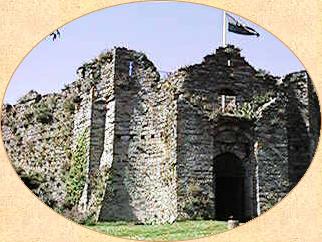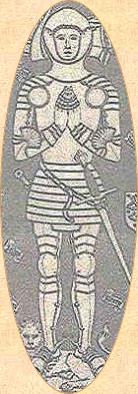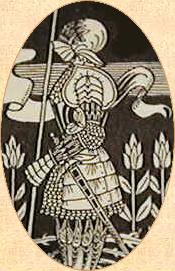
The
End
Tragedy accompanied the demise
of the de Braose barony. William and his first wife, known only
from surviving records as Agnes, had a son William. This son,
the de Braose heir, died in 1320.
William married his second
wife, the heiress Elizabeth de Sully, in 1317 but she remained
childless. William's oldest daughter Joan married James de Bohun
of Midhurst in about 1295, but she too died before her father
in 1323.

In
1297 William had won the valuable wardship of John de Mowbray
from the king in honour of his loyal service in Flanders. William
betrothed ten year old John to his six year old daughter Alina
and the young couple later became William's heirs. Gower was Alina's future inheritance but politics in
the marches of Wales became increasingly hostile.
In 1320, after the death
of his son, William sold the reversion of Gower to the earl of
Hereford, Humphrey de Bohun, who wanted it for his son after
Alina's death. William attempted some spectacular double dealings
with his other warlike neighbours. While Humphry de Bohun, Roger
Mortimer of Chirk and Roger Mortimer of Wigmore each claimed
to have received charters confirming their purchase of Gower
from William, Edward II promoted his self seeking favourite,
Hugh Despenser. John de Mowbray decided to settle the issue by
seizing Gower himself. All hell broke loose.
 The
king ordered the confiscation of Gower on October 26, 1320, because
William had not sought a royal licence to "alienate"
it to John de Mowbray. He sent a force to take it but at the
little chapel of Saint Thomas, by Swansea castle, armed men were
ready to prevent the seizure. Men of the king's own household
returned on November 13 with a larger and more successful force.
This was a challenge to the marcher lords' cherished autonomy.
They rose in revolt. In August 1321 a baronial coalition in parliament
banished Hugh Despenser and his father. John de Mowbray regained
Gower.
The
king ordered the confiscation of Gower on October 26, 1320, because
William had not sought a royal licence to "alienate"
it to John de Mowbray. He sent a force to take it but at the
little chapel of Saint Thomas, by Swansea castle, armed men were
ready to prevent the seizure. Men of the king's own household
returned on November 13 with a larger and more successful force.
This was a challenge to the marcher lords' cherished autonomy.
They rose in revolt. In August 1321 a baronial coalition in parliament
banished Hugh Despenser and his father. John de Mowbray regained
Gower.
Six months later a royalist
resurgence prompted the Despensers' return. At the battle of
Boroughbridge in March 1322 the royalists carried the day and
the terrible slaughter on the rebel side was exacerbated by the
executions which followed. John de Mowbray was drawn by three
horses and hung at York. His body was left there in chains for
three years. Alina had fled by boat to Ilfracombe in Devon but
her hiding place was discovered. She and her son John were thrown
into the Tower of London.
William was a broken man,
forced to give his last remaining lands to the king for a life
annuity. The outcome of Boroughbridge left him £10,000
in debt to Hugh Despenser. In his efforts to gain his daughter's
freedom William submitted to the conniving schemes of the Despensers
and relinquished almost everything he owned. From the Tower Alina
described him as "frantic and not in good memory ".
He never lived to see her free.
William died in 1326, ironically
the year the Despensers were executed. The king was deposed the
following January. Alina married Richard de Peshale, whom she
met when they were prisoners together in the Tower, and together
they held Gower until her death in 1331. Bramber passed to her
son John de Mowbray.
 Descendants
of Alina became dukes of Norfolk, the premier dukes of the land
to the present day. Minor branches of the family held manors
throughout the old barony but none ever attained the prominence
and notoriety of their forebears.
Descendants
of Alina became dukes of Norfolk, the premier dukes of the land
to the present day. Minor branches of the family held manors
throughout the old barony but none ever attained the prominence
and notoriety of their forebears.
The last de Braose of Sussex
died in 1426. This Sir John Brewes is commemorated in a
beautiful brass at Wiston church, near Steyning, illustrated
above. A branch of the family in Suffolk descended from
Richard, son of John and Llywelyn's daughter Marared. The
last of this line was Colonel John Brewes, buried at Little Wenham
in 1785.
Oddly, the de Braoses have
been immortalised in one of the great works of medieval literature.
Sir Thomas Malory's Le
Morte d'Arthur
has many Welsh roots. Malory was three times a member of
parliament but also a notorious law breaker. He attempted
to ambush and kill the duke of Buckingham. In 1450 he twice committed
extortion and rape and then he terrorised the monks of Combe
Abbey. In prison he wrote the history of Arthur and his
knights of the round table, the highest expression of chivalry,
although Malory had more in common with the villain of his tale,
a defiler of damsels and slayer of heroes:
"the falsest knight
of the world now living, and he is the most villain that ever
man heard speak of, and his name is Sir Breuse Saunce Pité".

back
to text

back to text
 The End |
||||
William married his second
wife, the heiress Elizabeth de Sully, in 1317 but she remained
childless. William's oldest daughter Joan married James de Bohun
of Midhurst in about 1295, but she too died before her father
in 1323.  In 1297 William had won the valuable wardship of John de Mowbray from the king in honour of his loyal service in Flanders. William betrothed ten year old John to his six year old daughter Alina and the young couple later became William's heirs. Gower was Alina's future inheritance but politics in the marches of Wales became increasingly hostile. In 1320, after the death of his son, William sold the reversion of Gower to the earl of Hereford, Humphrey de Bohun, who wanted it for his son after Alina's death. William attempted some spectacular double dealings with his other warlike neighbours. While Humphry de Bohun, Roger Mortimer of Chirk and Roger Mortimer of Wigmore each claimed to have received charters confirming their purchase of Gower from William, Edward II promoted his self seeking favourite, Hugh Despenser. John de Mowbray decided to settle the issue by seizing Gower himself. All hell broke loose.
Six months later a royalist resurgence prompted the Despensers' return. At the battle of Boroughbridge in March 1322 the royalists carried the day and the terrible slaughter on the rebel side was exacerbated by the executions which followed. John de Mowbray was drawn by three horses and hung at York. His body was left there in chains for three years. Alina had fled by boat to Ilfracombe in Devon but her hiding place was discovered. She and her son John were thrown into the Tower of London. William was a broken man, forced to give his last remaining lands to the king for a life annuity. The outcome of Boroughbridge left him £10,000 in debt to Hugh Despenser. In his efforts to gain his daughter's freedom William submitted to the conniving schemes of the Despensers and relinquished almost everything he owned. From the Tower Alina described him as "frantic and not in good memory ". He never lived to see her free. William died in 1326, ironically the year the Despensers were executed. The king was deposed the following January. Alina married Richard de Peshale, whom she met when they were prisoners together in the Tower, and together they held Gower until her death in 1331. Bramber passed to her son John de Mowbray.
The last de Braose of Sussex died in 1426. This Sir John Brewes is commemorated in a beautiful brass at Wiston church, near Steyning, illustrated above. A branch of the family in Suffolk descended from Richard, son of John and Llywelyn's daughter Marared. The last of this line was Colonel John Brewes, buried at Little Wenham in 1785. Oddly, the de Braoses have been immortalised in one of the great works of medieval literature. Sir Thomas Malory's Le Morte d'Arthur has many Welsh roots. Malory was three times a member of parliament but also a notorious law breaker. He attempted to ambush and kill the duke of Buckingham. In 1450 he twice committed extortion and rape and then he terrorised the monks of Combe Abbey. In prison he wrote the history of Arthur and his knights of the round table, the highest expression of chivalry, although Malory had more in common with the villain of his tale, a defiler of damsels and slayer of heroes:
|
||||